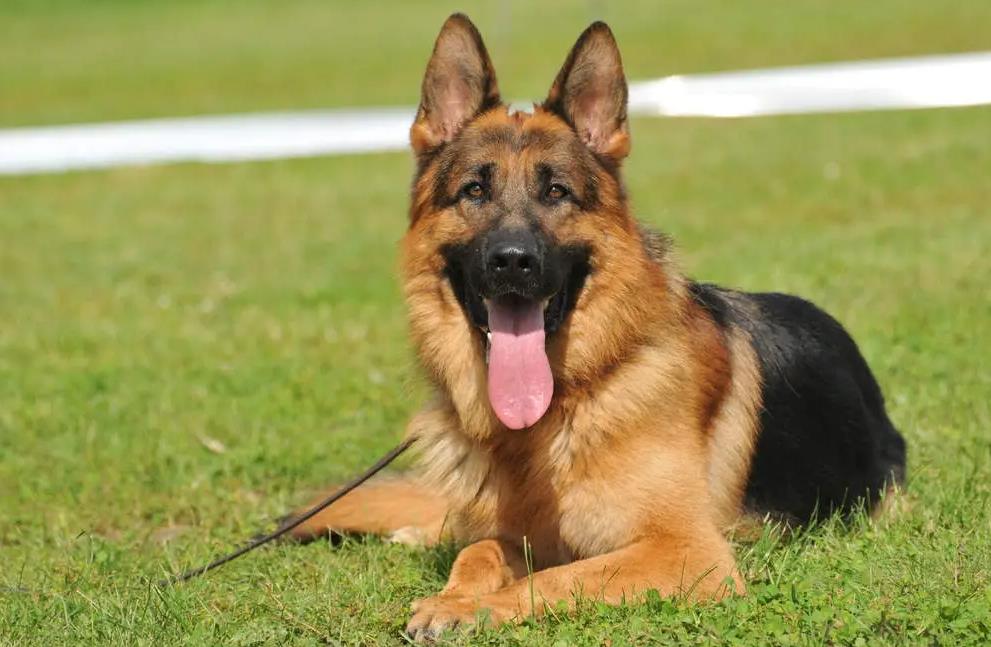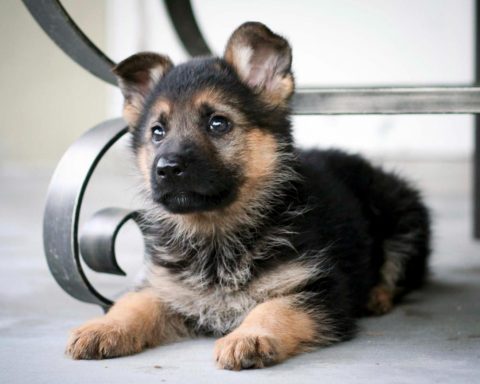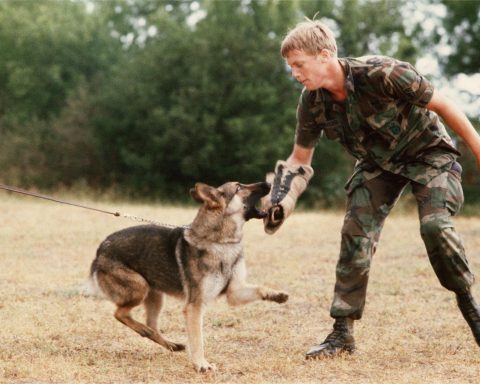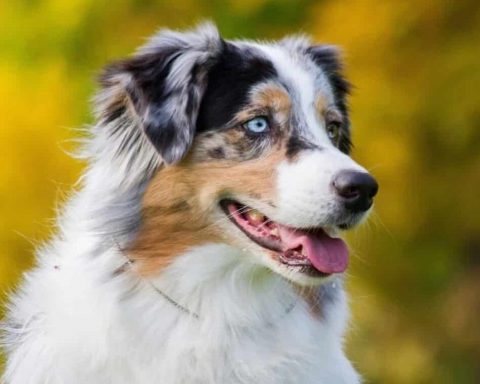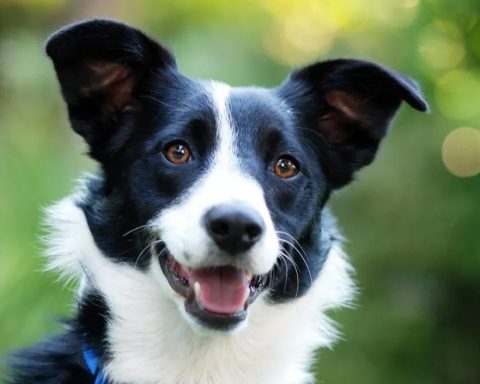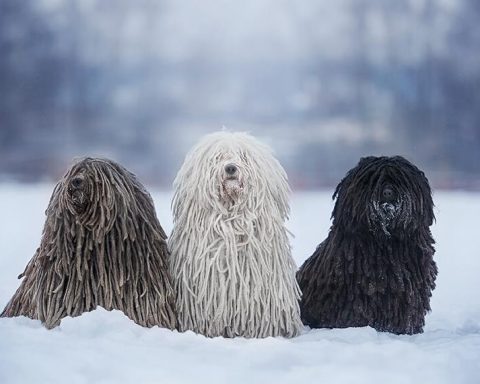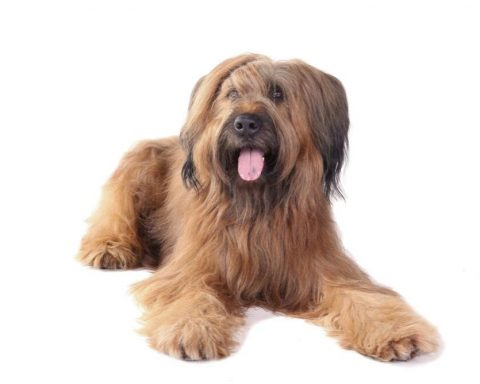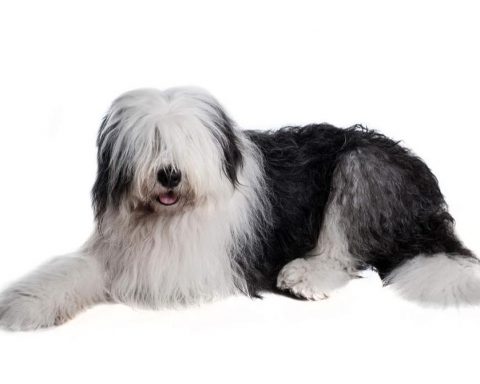Summary
A good German Shepherd gives the impression of being sturdy, agile, muscular, alert, and energetic. Very smooth, with a very harmonious front and hindquarters.
The length of the body is slightly greater than the height, the body is very deep, and the smooth curves of the body outline are better than the angles.
The body is firm rather than slender, and the impression is one of muscularity and agility both at rest and on the move, neither awkward nor weak. The ideal German Shepherd gives the impression of being of good quality, of indescribable nobility, but is distinguishable at a glance and cannot be mistaken.
The sex characteristics are very pronounced, and depending on their sex, they either appear majestic or soft.
Place of origin
Germany
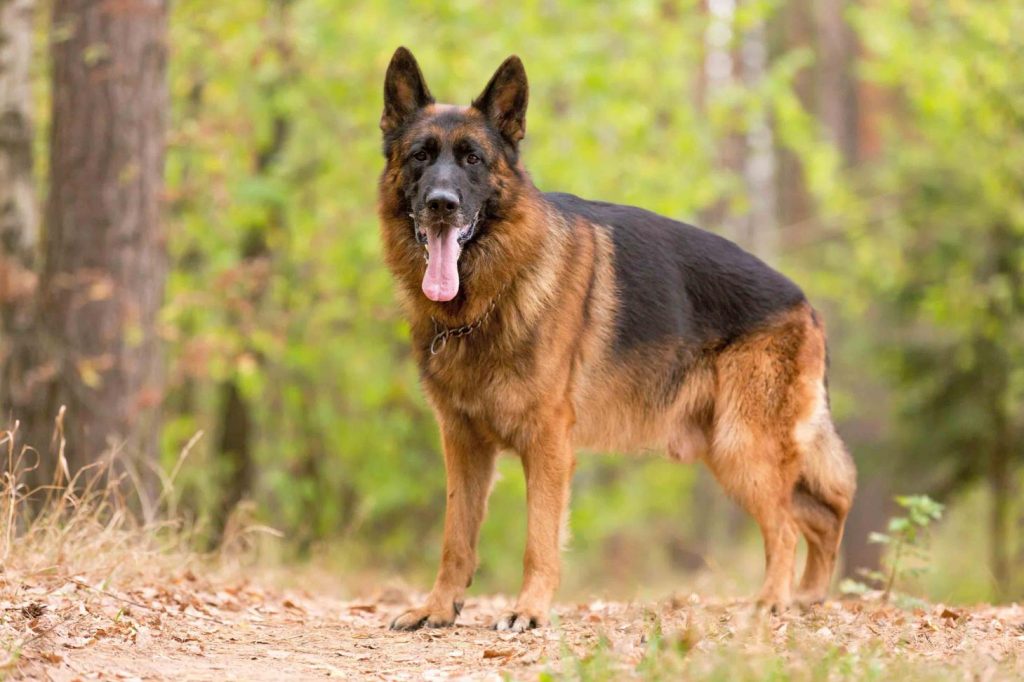
Temperament
This breed has very distinct personality traits: direct, bold, but not hostile. Expression: self-confident, markedly aloof, making him less approachable and building friendships. This breed must be approachable, stand calmly, appear confident, be open to arrangements and not stubborn. He should be tetchy, but opportunity permitting, he will appear enthusiastic and alert, with the ability to work as a companion dog, watchdog, guide dog, sheepdog or guard dog, whichever the job may be.
He must never appear timid or shy, hiding behind his master or the dog handler; he must never appear nervous, looking around, upward or showing nervousness, or tucking his tail if he hears an unfamiliar sound or sees an unfamiliar object. Lack of confidence in any environment is a sign of poor mental quality.
Lack of good temperament is of a serious defect, and it is best to get him off the playing field.
The referee must be allowed to examine his teeth, testicles, etc. Any attempt to bite the referee is classified as a disqualification.
The ideal German Shepherd should be a working dog that is not easily bribed, with a body build and gait that will enable him to accomplish very difficult tasks, which is the primary purpose of the standard.
Body Type
The ideal height at the shoulder for males is about 24 to 26 inches; for females, about 22 to 24 inches. The German Shepherd’s body length is slightly greater than his height, with an ideal ratio of 10/8.5, and body length is measured from the sternum to the end of the pelvis, where the sciatic bone protrudes. Ideal body length is not provided by the length of the back alone, but by the overall length (well-proportioned, in harmony with the height), and when viewed from the side, the components of body length include the length of the forequarters, the length of the malleolus, and the length of the hindquarters.
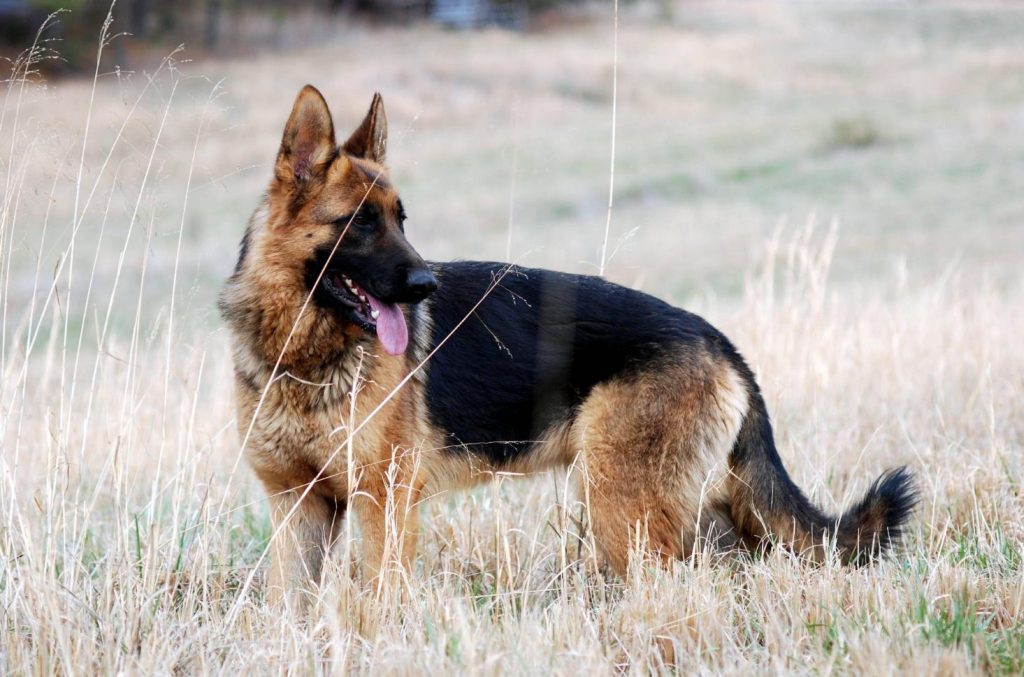
Head
The head is noble, with clean lines, sturdy but not coarse, but, overall, not too slender, in proportion to the body. The head of the male is distinctly masculine, while the head of the female is distinctly feminine.
Expression: Sharp, intelligent, composed. Eyes: Medium sized, almond shaped, slightly slanted in position, not protruding. Color as dark as possible.
EARS: Slightly pointed, in proportion to the head, forward, erect when attention is paid to them, the ideal position (ear posture) is one in which the center lines of the ears are parallel to each other and perpendicular to the ground when viewed from the front. Cropped or drooping ears are out of character. When viewed from the front, the forehead is moderately rounded and arched, the head is tilted and long, and the muzzle is wedge-shaped with an inconspicuous stop.
Muzzle: Long and firm, with contour lines parallel to each other and to the contour lines of the head.
Noseglasses: black. If the noseglasses are not thoroughly black they are out of order. The lips are very well fitted and the jaws are very strong.
Teeth: 42 teeth, 20 upper and 22 lower jaw teeth, strong teeth, claw bite. A protruding upper jaw bite or pincer bite does not meet the need and a protruding lower jaw bite is a disqualification. Dental system complete. Lack of all teeth except the first premolars is a serious defect.
Neck, dorsal line, and body
The neck is strong, and well muscled, well defined and relatively long, in proportion to the head, and without loose skin. When he is concerned or excited, the head is lifted and the neck held high; otherwise, the typical posture is one in which the neck is stretched forward (supporting the head) rather than upward so that the head is slightly above the shoulders, especially when in motion.
BACK LINE: The horse’s shoulder rump is in the highest position and slopes backward, transitioning to a flat, straight back. The back is straight and very firm with no sag or arch. The back is fairly short and with the entire body gives the impression of being deep, and reliable, but not bulky. Chest: Begins at the sternum, full, and goes down between the legs. The chest is deep and broad, not shallow, giving ample room for the heart and lungs, and protruding forward, the sternum protruding before the shoulder blades when viewed in profile.
Ribs: well expanded and long, neither barrel chest nor flat chest. The ribs extend downward to the elbow position. Correct rib organization permits free movement of the elbow back and forth as the dog trots. Ribs that are too round interfere with elbow movement and turn the elbow out; ribs that are too flat or too short cause the elbow to bend inward. The ribs are properly set back, making the waist relatively short. The abdomen is firm, without a large belly. Lower abdominal curve is only moderately uplifted at the waist Waist: wide and strong when viewed from above. Observed from the side, the length from the last rib to the thigh is incorrect and is out of place. The hips are long and gradually sloping.
Tail: The hair is thick and the caudal vertebrae extend at least to the fly joints. The tail is smoothly integrated into the rump and positioned low, not too high. At rest, the tail hangs straight down, slightly curved and sabre-like. A slight hook, sometimes crooked to one side of the body, is a defect (to the extent that it would spoil the overall appearance). When the dog is excited or in motion, the curve intensifies and the tail protrudes, but never curls beyond the vertical line. A short tail, or a stiff end is a serious defect. A broken tail is a disqualification.
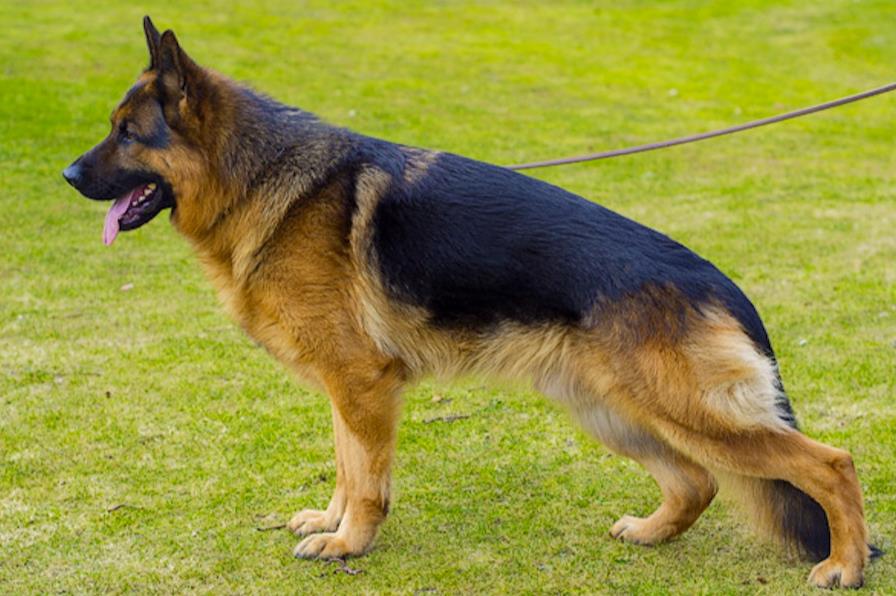
Forequarters
The scapulae are long and sloping, lying flat and not very far forward. The upper arm forms a right angle to the scapula. Both the scapula and the upper arm are well muscled. The forelegs are straight regardless of the angle from which they are viewed, and the bones are ovoid rather than rounded. The stifle is strong and flexible, and makes a 25-degree angle with the vertical line. The wolf claws of the forelimbs may be removed, but are usually retained. The claws are short, the toes are compact and rounded-arched, the pads are thick and firm, and the toenails are short and dark black.
Hindquarters
When viewed from the side, the entire thigh tissue is very wide, and both upper and lower parts of the thigh are well muscled, firm, and at right angles wherever possible.
The upper thigh bone is parallel to the scapula, while the lower thigh bone is parallel to the upper arm bone.
The metatarsal bones (the part between the fleur-de-lis and the paw) are short, strong and closely united.
Wolf claws, if present on the hind limbs, must be removed. The foot claws are the same as those of the forelimbs.
Coat
The ideal dog has a double coat of medium length. The outer cloak of hair is as dense as possible and is straight, coarse, stiff, and flat against the body. A slightly wavy coat, usually of bristly texture, is permissible.
The head, including within the ears, forehead, legs and paws are covered with shorter hair, and the neck hair is long and dense. On the forelegs and the back of the hind legs, the hair is slightly longer and extends to the quills and fly joints respectively.
Defects:
- Soft coat
- Silky coat
- Outer cloak too long
- Woolly textured coat
- Curly coat
- Open coat
Color
German Shepherds are colorful and most colors are permitted. Intense colors are preferred. Dull colors, fades, orchids and liver colors are serious defects. White dogs are disqualified.
Gait
The gait of the German Shepherd is of the trotting type. His body structure determines that he can do his job. General impression: his gait is beyond imagination, elastic, very relaxed, smooth and rhythmic, with a very large stride and low frequency. When pacing, the stride is large because the front and hind limbs are very large.
At the trot, the stride of the front and hind limbs is not as large, but the overall stride is still quite large, the movement is powerful but easy, and because of the coordinated and balanced movement, the gait is firm, like a well-lubricated machine.
The paws are very close to the ground, both when extending forward and when stomping backward. Very well developed muscles and strong ligaments are required to achieve the ideal gait of this breed. The hindquarters drive, through the back, delivers strong power (slightly upward) to the entire body and propels it forward.
(Hind limbs) Stretching a long way under the body, stepping over the tracks left by the forefoot claws, the hind foot claws grip the ground tightly, and the flying knuckles, the hind knees, and the upper part of the thighs begin to move in a backward stomp.
Until the hind limb movement is complete, the hind foot paw remains close to the ground and moves smoothly. An overextended hind limb, which causes one hind paw to land on the outside of the forefoot paw trail and the other hind paw to land on the inside of the forefoot paw trail, is not considered a defect unless he deviates from the correct walking line and walks diagonally to one side.
TRANSMISSION: The typical smooth, fluid gait requires a firm, stable hindquarters. The entire effort of the hindquarters is transmitted to the forequarters through the lats, back and shoulders. For a correct trot, the backline must remain firm and level, not swaying, rolling, flopping, or arching. A backline that is not horizontal (the horse’s shoulder rump is lower than the hips) is a defect.
In order to match the forward drive provided by the hindquarters, the shoulders must be completely relaxed and the forelimbs must be extended a great deal to match the movement of the hindquarters. The German Shepherd’s tracks should not be two very well separated parallel lines, and at the trot the paws should be turned inward, close to the centerline of the body, to maintain balance. The tracks are close together but should not overlap or cross.
When viewed from the front, the forelimbs (from the shoulder to the pads of the feet) form a straight line; when viewed from the rear, the hindlimbs (from the hips to the pads of the feet) form a straight line. Defects: An incorrect gait (whether viewed from the front, from behind, or from the side) is considered a serious defect.
Disqualification
- clipped or drooping ears
- Nasal mirrors that are not completely black
- Protruding lower jaw
- Broken tail
- White coat
- Attempts to bite the referee
